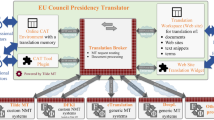Abstract
The design of a Translator Workstation is an engineering task involving technical aspects like dictionary organization/retrieval and natural language processing, as well as human aspects like friendly user interface and user accessibility. This paper describes the design and implementation of such a workstation for translating English texts into Malay. Although specifically developed for English-Malay translation work, most of the ideas and features presented are language independent. Important issues raised include translation modes and functions, dictionary and thesaurus organization, morphological processing, spelling check and special word processing features.
Similar content being viewed by others
References
Melby, Alan. 1983. Computer-assisted translation systems: The standard design and a multi-level design. Proceedings of the Conference on Applied Natural Language Processing, California, 1–3 February 1983.
Pollock, Joseph J., and Antonio Zamora. 1984. Automatic spelling correction in scientific and scholarly text. CACM 27:4.358–68, April 1984.
Tong, Loong-Cheong. English-Malay translation system: A laboratory Prototype. 1986. Proceedings of COLING86 (Bonn), 639–42.
Author information
Authors and Affiliations
Rights and permissions
About this article
Cite this article
Tong, LC. The engineering of a Translator Workstation. Mach Translat 2, 263–273 (1987). https://doi.org/10.1007/BF01682184
Issue Date:
DOI: https://doi.org/10.1007/BF01682184




